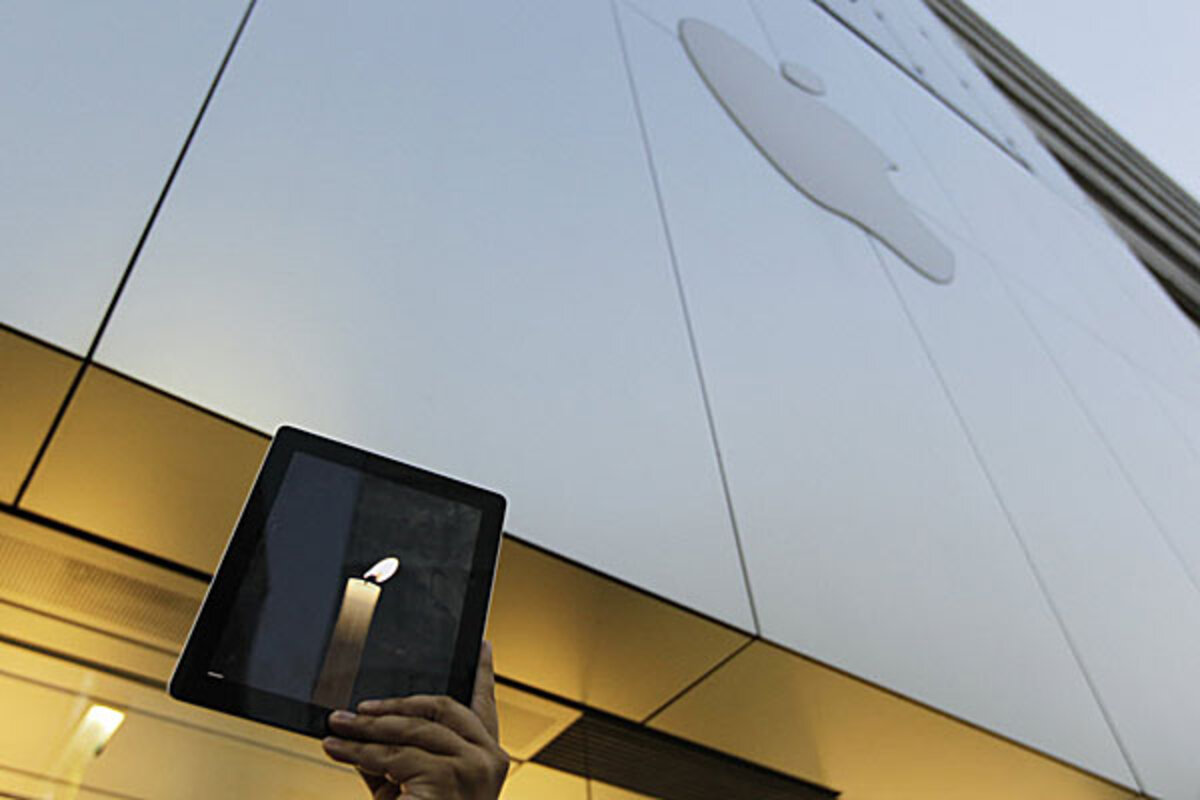Steve Jobs: what we can learn from how he lived
Loading...
| Los Angeles
Steve Jobs would be proud.
Just like the inveterate tinkerer that he was, everyone from university-level educators to homeschooling parents have spent the better part of the past ‚Äúi‚ÄĚ decade trying to figure out the secret to the Apple founder‚Äôs genius ‚Äď and how to teach it to, or maybe simply nurture it in, the next generation.
The key, say many who have spent both personal and professional time roaming the chapters of the Silicon Valley inventor’s life, is to appreciate his developmental years and grasp the principles that guided his mature efforts.
Certain traits drove his entire lifework, says Carmine Gallo, author of ‚ÄúThe Innovation Secrets of Steve Jobs: Insanely Different Principles for Breakthrough Success.‚ÄĚ ‚ÄúHe had vision, passion, and focus, for starters,‚ÄĚ he says, adding, ‚ÄúThese were obvious from his youngest years.‚ÄĚ
Two things from his youth stand out, says Peter Atkins, former Microsoft general manager. Mr. Jobs grew up in Silicon Valley, he points out. ‚Äú[H]is adoptive father, Paul Jobs, worked with Steve in their garage taking apart various electronic devices,‚ÄĚ he notes via e-mail. ‚Äú[T]his regular, coached exposure to how things work likely spurred Jobs' interest in computers ‚Äď and gave him a huge experience edge over most kids his age in understanding them.‚ÄĚ
Then, when Jobs was 13, he was building some electronic devices, but did not have the required parts. ‚ÄúJobs, who must at that point already have had amazing self-confidence, called Bill Hewlett, the co-founder of Hewlett-Packard (which was based near his home),‚ÄĚ says Mr. Atkins, who is the founder of Permian Partners, an Internet investment fund. Although Mr. Hewlett did not know Jobs, he talked with him and gave him the required parts ‚Äď and also offered Jobs a summer position at Hewlett-Packard, where he later met Steve Wozniak, with whom he'd found Apple.
Fast-forward to his young adult years, and more lessons emerge, says Mr. Gallo. Jobs dropped out of Reed College in Portland, Ore., instead attending classes that piqued his interest ‚Äď such as calligraphy. ‚ÄúJobs had no idea how this might fit into a future career, but he just understood that it was connected to his passion and interest. And so he pursued it with the same commitment and focus he would bring to his later creations,‚ÄĚ Gallo says.
‚ÄúSo of course, look at where it ultimately led,‚ÄĚ he notes. ‚ÄúThe Mac really introduced the idea that we should all have creative and beautiful fonts on our computers.‚ÄĚ
Jobs also spent time on an Oregon commune with an apple orchard, where, according to Gallo, he birthed the name for his future firm. ‚ÄúWozniak came to pick him up from the commune, and Jobs told him he had the name for their company,‚ÄĚ he says. ‚ÄúIt should be Apple, Jobs told him, because an apple is something everyone can understand.‚ÄĚ
As for how the commune visitor became an epic entrepreneur, timing is everything, says Geoffrey Orsak, dean of Southern Methodist University’s Lyle School of Engineering in Dallas.
Jobs came out of a ‚Äúpost-hippie, Bay Area culture that began to feel the growing pressure of actually finding a career when the poetry readings and protests started to wane,‚ÄĚ he says via e-mail. A few miles south, a small informal gathering of tech tinkerers was emerging as the crucible of the new Silicon Valley, and ‚ÄúJobs was poised to become the coolest kid in the class,‚ÄĚ he says.
He wasn‚Äôt a product of the cold-war generation that started HP and Intel, cemented in the notion of the orderly progress of both technology and society, Mr. Orsak says. Jobs had an innate sense of a new emerging generation whose members never saw themselves as consumers of technology, says Orsak. ‚ÄúHis strength was in pursuing his vision when others were headed in different directions,‚ÄĚ he adds.
So, asks Orsak, how do we grow more ‚Äúmad thinkers‚ÄĚ like Steve Jobs?
This is where many in higher-education circles have paid close attention, says Polly Black, director of the Center for Innovation, Creativity and Entrepreneurship at Wake Forest University in Winston-Salem, N.C. Wake Forest‚Äôs entrepreneurship program, she says, flows from Jobs‚Äôs extreme and passionate focus on ‚Äúmaking meaning, not money.‚ÄĚ
The program is a minor, housed inside the liberal-arts curriculum, ‚Äúfor a reason,‚ÄĚ Ms. Black says. ‚ÄúWe want people to see the larger connections between ideas and disciplines.‚ÄĚ
She is quick to add that the wedding of the practical and the visionary is inextricably tied to lessons from Jobs‚Äôs life. ‚ÄúJobs remained remarkably aligned with consumers, insisting their point of view came first,‚ÄĚ she says, adding that his focus on consumer needs helped him create products that slid into the right place, just before consumers realized they needed that product.
Jobs surrounded himself with savvy people, says Black. ‚ÄúJobs had the vision but needed a team to help build it out,‚ÄĚ she says, noting that he believed strongly in the team function at Apple and considered everyone an integral part of the company‚Äôs success. His final email, she says, started out: ‚ÄúTeam ...‚ÄĚ
The Wake Forest program encourages students to work in teams made up of people whose strengths differ from one another, Black says. The university seeds start-ups on campus, she notes, which gives students an opportunity to safely experience another important life lesson from the Jobs narrative ‚Äď how to learn from failure.
‚ÄúJobs was fired from his own company,‚ÄĚ Black says with a laugh, yet he never lost his focus or his passion and came back bigger than ever.
Jobs has been a great source of inspiration, says homeschooler Doug Newcomb, senior technology writer at Edmunds.com and father of two. But, he says, it can be tricky encouraging creativity while ensuring that his offspring don’t shirk their studies.
What I try to teach my kids, he says, ‚Äúis that [they] should work hard and stick with [their] vision no matter what the world says about it.‚ÄĚ




